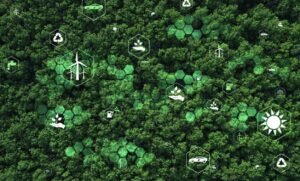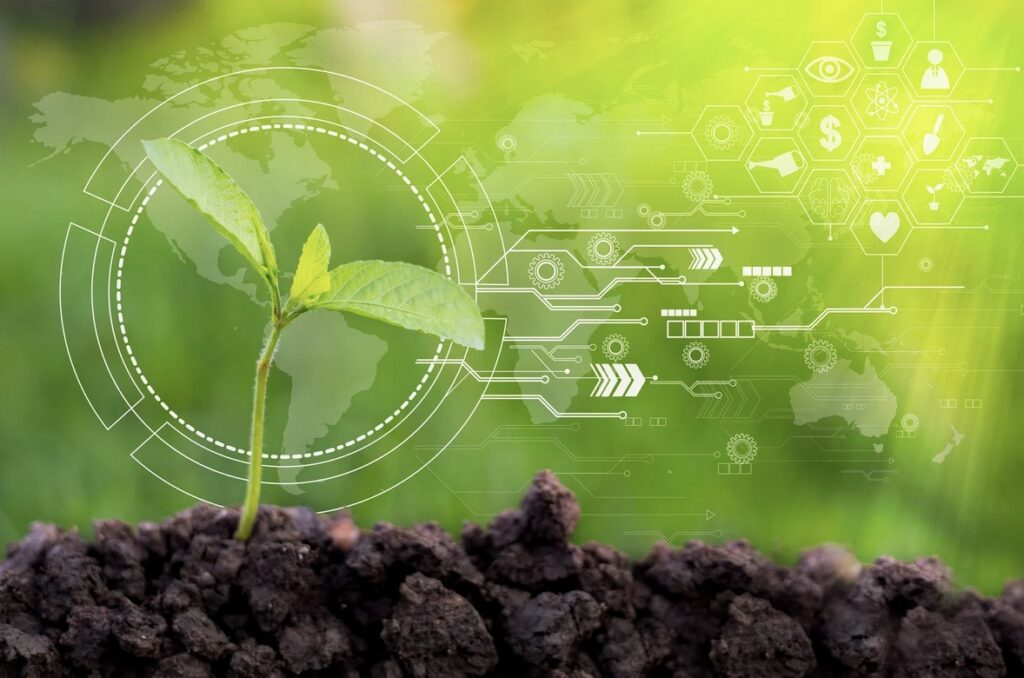Understanding Green Technology and Sustainability
Green technology, often termed as ‘clean technology,’ signifies an umbrella term. Underneath this umbrella, you find a suite of practices, products, and resources that use technology and science to create an eco-friendly impact.

Consider solar panels for instance. These sun-soaking devices aim to generate electricity, with zero emissions during operation. This feature qualifies them as a prime example of green technology in action.
Shifting the lens towards sustainability reveals its inner link to modern practices. Sustainability acts as the guiding principle for modern organizations and governments, steering them toward practices that ensure the survival and success of all life forms on our planet.
Thus, it portrays how sustainability underpins the conduct of organizations today and their efforts towards a balanced and continual existence.
Take the concept of sustainable agriculture as a case. Modern practices in this domain prioritize soil health, water quality, and animal welfare, all aimed at food production that can sustain present and future generations.
Current Trends in Green Technology
Green Technology continues to evolve, presenting innovative solutions to modern environmental challenges. Within the domain of Renewable Energy and Sustainable Building Technologies, there are notable developments reshaping the landscape.
Innovations in Renewable Energy
New renewable energy solutions demonstrate the potential for cleaner power generation. Examples include concentrated solar power solutions that utilize mirrors or lenses to focus a large area of sunlight into a small beam, significantly enhancing energy production. Additionally, advancements in wind turbine design have enabled more efficient energy production. For instance, bladeless turbines offer a less resource-intensive and more bird-friendly alternative to traditional turbines.
Developments extend also to the storage aspects of renewable energy. Current green technology trends reveal smaller, higher-capacity battery designs that facilitate better energy storage, contributing to a more reliable and consistent power supply despite weather fluctuations. Notably, Tesla’s Powerwall battery showcases a practical application of such advancements.
Sustainable Building and Construction Technologies

Parallel innovations occur in the sustainable building and construction industry. Green constructions lately adopt more environment-friendly materials, such as low-emission glass and solar reflective surfaces, to enhance energy efficiency. Eco-conscious designs, including green roofs that manage stormwater and reduce heat build-up, have become a norm.
The implementation of smart technology in buildings also characterizes the current trends. Energy management systems keep track of a building’s energy usage, helping to reduce unnecessary wastage. Plus, advancements in water-saving fixtures, like low-flow faucets and dual-flush toilets, promote efficient water use. For building owners looking to take a more strategic approach, professional energy retrofit consulting services can help identify the most impactful upgrades and guide projects from planning to execution, ensuring both energy savings and long-term operational efficiency.
Predictions for Green Technology Advancements
Trends suggest that green technology continues its upward growth trajectory. For instance, renewable energy technologies like high-efficiency solar panels and bladeless wind turbines keep evolving, with manufacturers striving for higher energy conversion rates. Energy storage solutions such as high-capacity batteries, which were once a significant concern, show promising developments, increasing the potential for a more extensive rollout of renewable alternatives.
Similarly, architects aren’t forgetting about green technology. In their blueprints for future structures, eco-friendly building materials dominate. It’s also likely that more smart technologies get integrated into homes and offices, optimizing energy usage. Moreover, fixtures that conserve water, an increasingly precious resource, receive more attention.
Overall, advancements suggest green technology’s prominence will only deepen in the coming years, underlining its key role in sustainable practices.
The Impact of Policy on Sustainable Development
Public policy plays a crucial role in encouraging or hindering sustainable practices. By providing incentives to adopt green technologies, governments can significantly influence their proliferation. They may offer subsidies, tax credits, or grants to individuals or businesses investing in renewable energy or sustainable building projects, augmenting the appeal of these ventures despite their potential initial high costs.

However, policy isn’t solely defined by government actions. Industry standards and regulations also heavily factor in. These can include manufacturing processes aimed at reducing waste, corporate sustainability objectives, or industry-wide initiatives to switch to renewable energy sources.
Even market unpredictability, often seen as a barrier to green technology adoption, can be mitigated by effective policy measures. These could include feed-in tariffs or public insurance schemes that offer protection against adverse market conditions.
The direction of policy and legislation, therefore, holds enormous potential in shaping the future trajectory of sustainable practices. It shows how significant a role laws and regulations, from government or within industries, possess in influencing the landscape of green technology.

